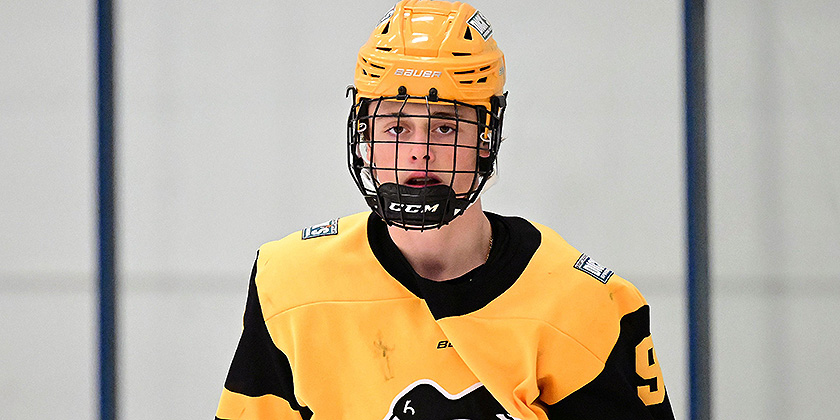
Kieren Dervin (F, L, 6’2″, 181, Kingston Frontenacs, 03/31/2007, Penn State)
Kieren Dervin is a versatile two-way forward with a projectable frame, a competitive motor, and the intelligence to impact the game in all three zones. His skill set is headlined by agility, poise with the puck, and an ability to make high-skill plays in tight spaces. He was dominant at the prep level with St. Andrew’s and showed flashes of translatable tools in his short stint with Kingston (OHL), but his statistical profile and past viewings raise questions about his physical engagement, puck management, and pace of play against better competition. Dervin is an upside swing who could develop into a reliable 200-foot contributor with middle-six ceiling if he tightens up his game at pace.
Case For Drafting Kieren Dervin:
Dervin was a dominant offensive force at the U18 prep level with 92 points in 61 games, posting 1.83 completed passes per game that led directly to Grade “A” scoring chances. His puck processing, anticipation, and playmaking instincts are legitimate assets, and he shows poise in handling pressure both off the rush and in-zone. His high-end loose puck recoveries (3.2 per game) at the U18 level are an indicator of both skill and effort—he’s around the puck consistently, with soft hands and good balance through traffic.
He’s also an effective face-off man at the prep level (56%) and competes well in puck battles (65% win rate in the U18 circuit). He played with structure and pace at St. Andrew’s and has shown an ability to support the puck, kill penalties, and drive transition when given space.
In his limited OHL sample (10 games), Dervin didn’t look out of place and managed 3 points while playing limited minutes in a middle-six role. His ability to create (0.71 passes per game leading to Grade “A” chances) at that level shows some translatability in his offensive game. Neutral Zone scouts consistently talked his high compete, vision, puck protection and timely goal-scoring in key moments.
Case Against Drafting Kieren Dervin:
While Dervin excelled at the prep level, his statistical drop-off in the OHL and underlying numbers raise some flags. His pass completion percentage in the OHL (84%) and especially in U18 (80%) are both below expectations for a high-skill forward—suggesting a tendency to force plays and expose the puck while under pressure. His low penalty differential (0.07 drawn/game) and physical outputs (0.29 hits/game in OHL, 0.71 in U18) point to a need to improve his physical engagement and willingness to battle through contact.
Despite having good size (6’1″, 183), Dervin loses over half of his 50/50 puck battles in the OHL (48%) and struggles at the dot (44%). These numbers reflect he is still developing strength and the core stability to be a power forward in junior hockey and beyond. He also averages 2.4 giveaways per game in both leagues, which when paired with his poor pass rate, reinforces the concern around decision-making with the puck against higher-end competition.
In short: his prep dominance hasn’t yet translated to OHL consistency, and his ability to play through pace and physicality remains an open question.
Projection:
Dervin projects as a long-term development forward with middle-six offensive upside if he can grow into his frame, add more strength and explosiveness, and clean up his puck management. He will need time in the NCAA (Penn State commit) to refine his pace, raise his decision-making speed, and become more of a 200-foot threat at tempo. His natural hockey sense, offensive skill, and ability to manipulate time and space give him a foundation worth investing in.
Recommendation:
Draft Grade: End of 3rd–5th
Dervin is a high-upside, medium-risk play who dominated at the prep level and held his own in limited OHL action. If he adds strength and processes the game faster, he could carve out a role as a cerebral middle-six center or playmaking winger. With a full year of junior hockey and two years of off-ice training at Penn State and the drafting team could be getting a middle-six power forward in the middle rounds.
Photo credit: Dan Hickling/Hickling Images
